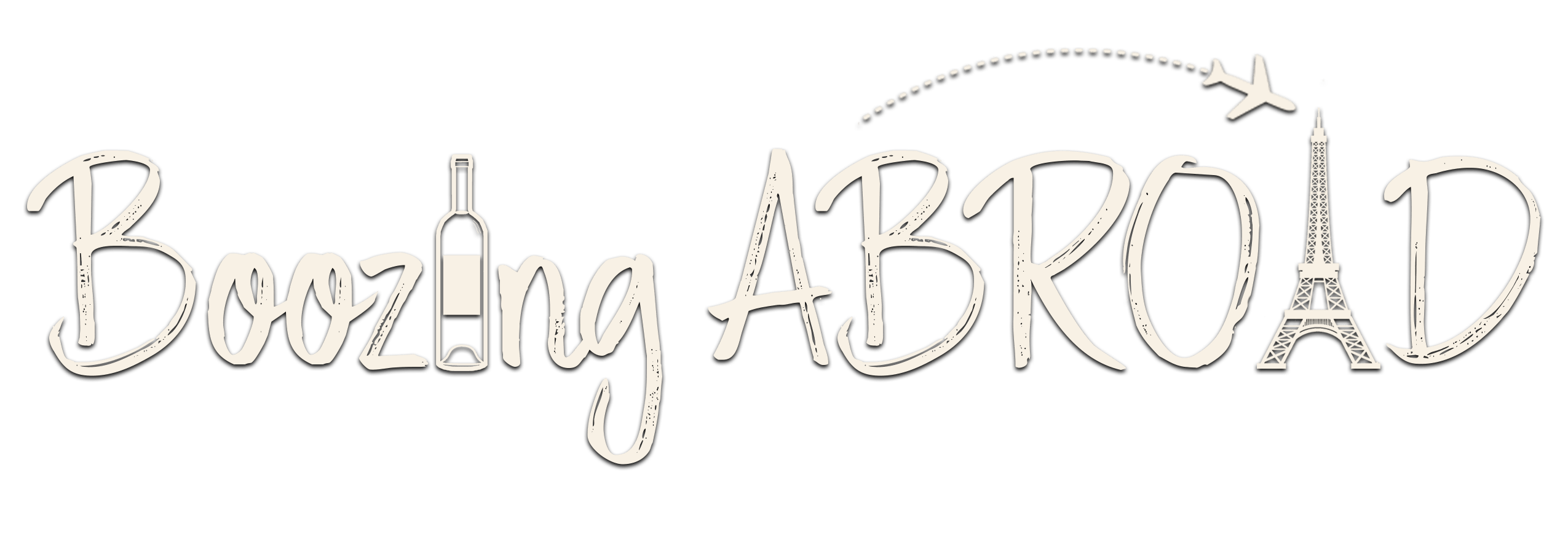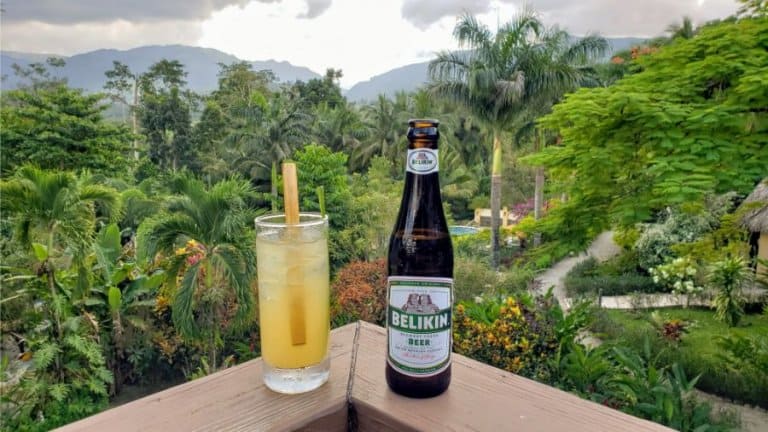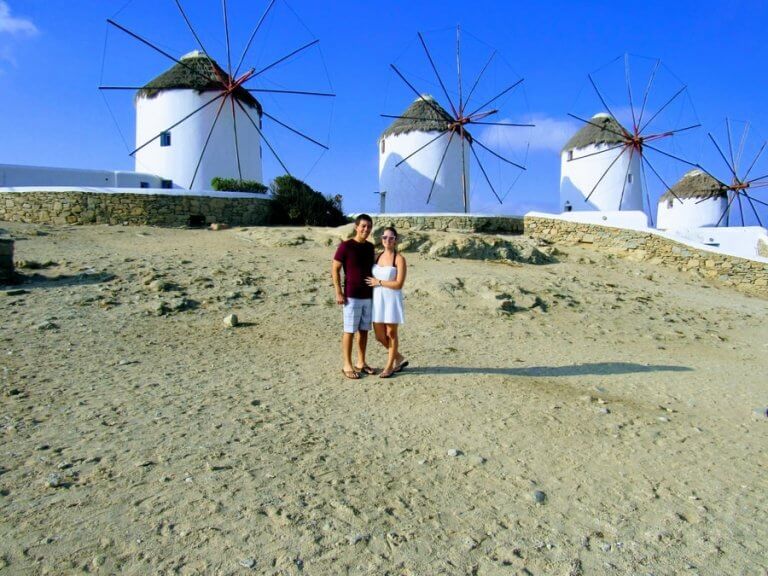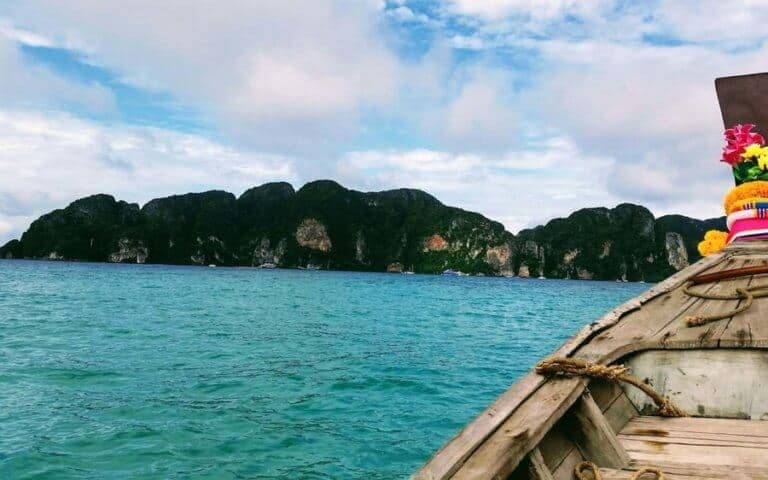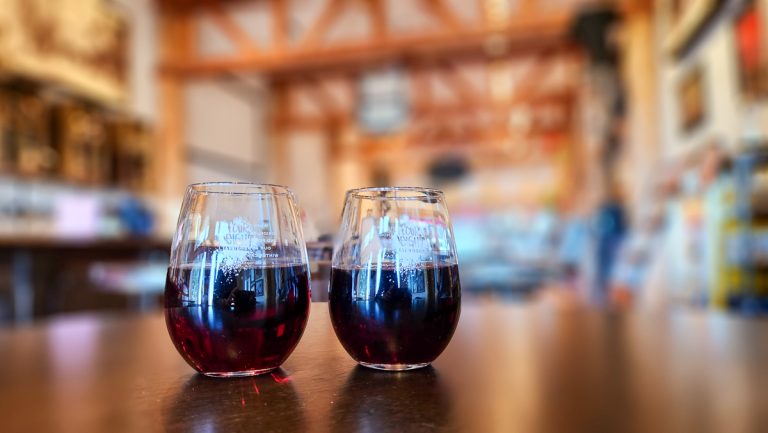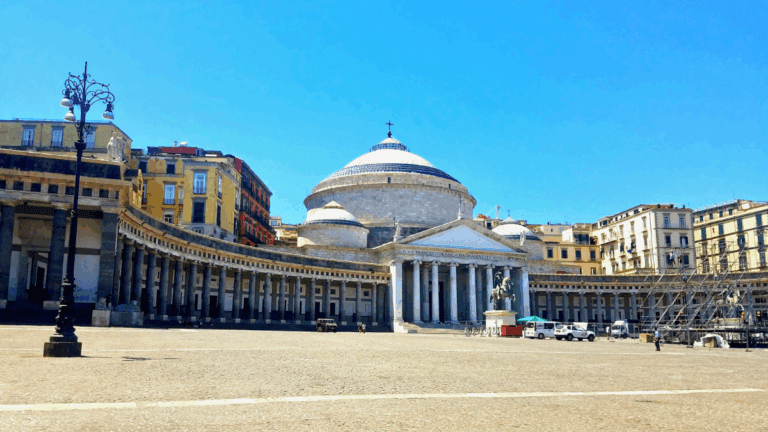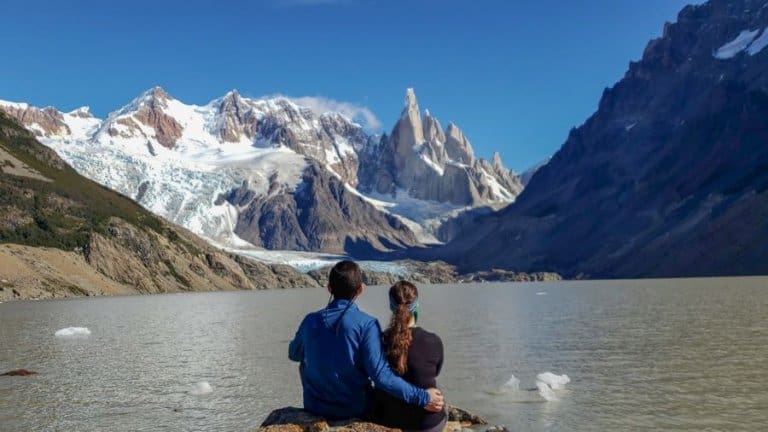The Ultimate Road Trip to Tuscany: A Wine Lover’s Paradise
Embarking on a road trip to Tuscany is an experience that combines breathtaking landscapes, centuries-old traditions, and the chance to savor some of the world’s most prestigious wines.
With its rolling hills, medieval towns, and world-renowned vineyards, Tuscany is a destination that feels like stepping into a postcard. This three-day itinerary takes you through some of Tuscany’s iconic wine-producing regions—Montalcino, Pienza, and Montepulciano—combining history, indulgence, and beautiful scenery.
Whether you’re a wine enthusiast or simply looking to immerse yourself in the charm of Italy, this itinerary is the perfect guide to making the most of your road trip to Tuscany.
Short on Time? Here are the key takeaways:
- Renting a car from Bologna was cheaper than a train from Bologna to the Tuscany area; plus, it gave us much more freedom and flexibility
- We spent a long weekend in southern Tuscany and we highly recommend more time
- Montalcino and Montepulciano are filled with hundreds of wineries
- Unlike most wineries in the US, you likely need reservations to taste (unless you are in a town)
Boozing Abroad contains affiliate links throughout the site. If you choose to purchase items through these links, we will earn a small commission at NO extra cost to you. Read the full disclosure policy here**
Getting to Tuscany
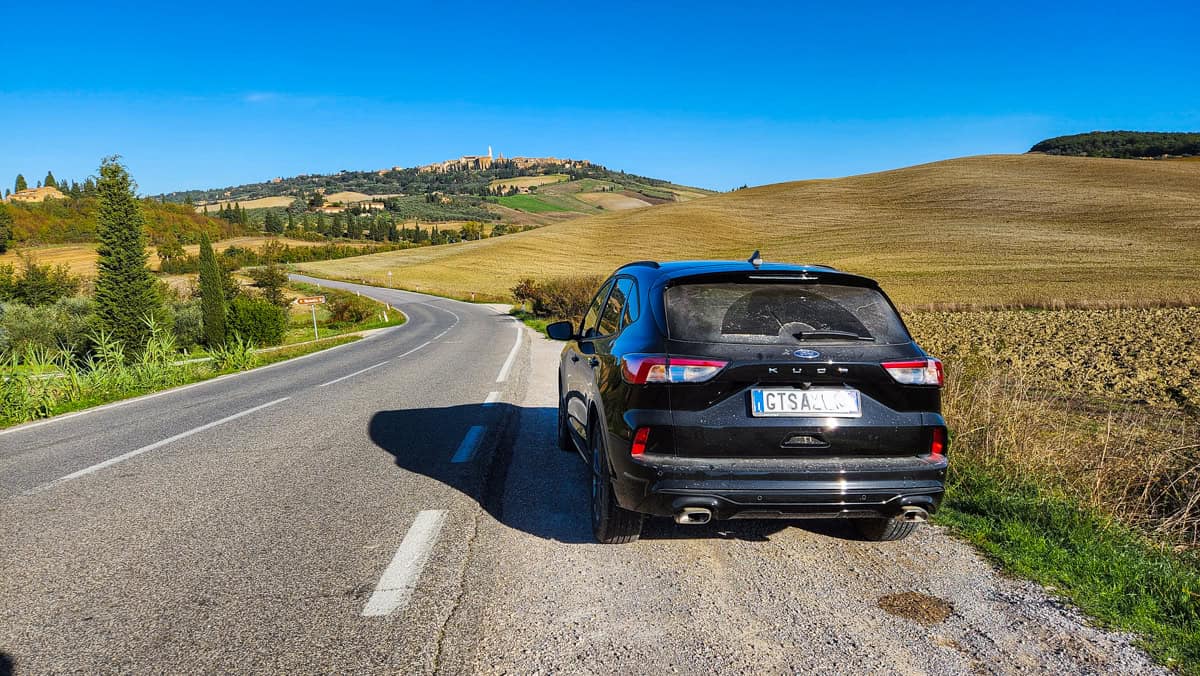
It has been a dream of ours to go on a road trip to Tuscany since we started our love affair with wine. We’ve been fortunate to experience the Chianti region closer to Florence, but this would be our first time in southern Tuscany.
We live in Bologna, which isn’t too far from the southern Tuscany region, so we had a couple options for transportation, both of which involved renting a car because doing this type of wine weekend without a car would be incredibly difficult, if not impossible (unless you hire a driver which can get expensive QUICK):
- Train to Florence, rent a car there, and drive about an hour and 15 minutes to the Pienza area
- Rent a car in Bologna and drive the 2.5 hours to the Pienza area
We were pleasantly surprised to learn that it was significantly cheaper to go with option #2, renting a car in Bologna, so that’s what we did. This gave us a significant amount of freedom and flexibility to experience our wine weekend on our own schedule and for a fraction of the cost!
This was our first time using Discover Cars for a car rental and we won’t be using any other site again. If you’ve never heard of them, don’t worry – we hadn’t either.
Think of it as the Booking.com of car rentals — it streamlines the process, offering options from major rental brands and smaller local businesses all in one spot.
The site is super easy to navigate (bonus: they have an app!), and in some cases, you don’t even have to pay until you pick up your car. If you’re planning your own Tuscan road trip or any trip, really, this is the way to go!
Where to Stay in Southern Tuscany

We had wine tastings reserved throughout the Montalcino and Montepulciano area so we wanted to be centrally located to cut down on travel time.
Less time in the car = more time exploring the towns and enjoying the wines.
During our research, we read horror stories about trying to drive and park in the hilltop towns so we opted to stay outside of these towns at the Agriturismo Lunadoro.
This spot gave us stunning views of Pienza in the distance, offered a very good breakfast for 8€ a person, as well as a full kitchen to use if we wanted to save some money and eat in (spoiler alert: we didn’t!).
If we are being totally honest, this place was fantastic…except for us, the beds were a bit firm; otherwise, it would have been perfect.
Having now spent time in the towns of Montalcino, Pienza, and Montepulciano, we would absolutely recommend staying in or near the towns (so long as you don’t mind walking suitcases up steep hills). But these agriturismos are still a great option if you want to be outside the hustle and bustle of the somewhat more-touristy towns and you have that all-important rental car to make scooting around the area easier.
If you want to see all the options available for hotels, click here.
General things to know about wine tasting in Tuscany

With literally hundreds of wine producers (and beer and liquor as you’ll read later) dotting this area of the map, it can be incredibly difficult to decide where to even begin.
At the time of planning this trip, we mostly picked our places based on availability (obviously) and if we could book online. We are still learning Italian so getting reservations on the phone was, right or wrong, a terrifying thought.
In hindsight, a large portion of the wineries had an English speaker, or at least they spoke enough English that we could have made a reservation with our limited Italian. That being said, we don’t feel like we just “settled” for somewhere just because they had online bookings…we went to some really awesome places!
When you’re planning your road trip to Tuscany, you need to plan your time accordingly.
Sounds straightforward and obvious, but what do we really mean by that?
Well, in the US, we’ve done countless wine tastings and it usually feels like a situation of “get you in and get you out as quickly as possible.”
That couldn’t be further from the truth of our experience in Italy (much like most everything else in Italy). Tastings often last at least an hour and sometimes even more if you strike up a good conversation with the workers (ask us how we know).
Now, there are certainly some tasting experiences available that are built for speed, but in our opinion, we enjoyed the slower pace as we got the chance to talk to the producers and the people behind these iconic wines.
It made us appreciate the wine and our time that much more (and our livers probably appreciated the slower pace too).
Also, as we mentioned above, while reservations may not technically be required at every winery in the region, we’d HIGHLY recommend booking tasting reservations for your Tuscany road trip.
Other than the obvious reason that they truly might not have availability for you, many of these tasting rooms are located on working farms or on someone’s house property, so having a reservation ensures that someone will be around to guide you through your tasting.
Watch the Adventure on YouTube
Don’t feel like reading all this? We gotchu! See both videos below!
Part 1
Part 2
Map of our Tuscany Road Trip
HOW TO USE THIS MAP: To view the layers and see the names of the places on this map, click the tab in the top left corner. You can select the check marks to show or hide certain layers. If you select the icons on the map, you will get more information about the point of interest.
HOW TO SAVE THIS MAP: If you select the star icon next to the map name, you can save this map to your Google Maps account. To view it, open Google Maps in desktop or on your phone, select the menu button, go to “Your Places,” scroll to the right to Maps, and you will see this map.
Montalcino
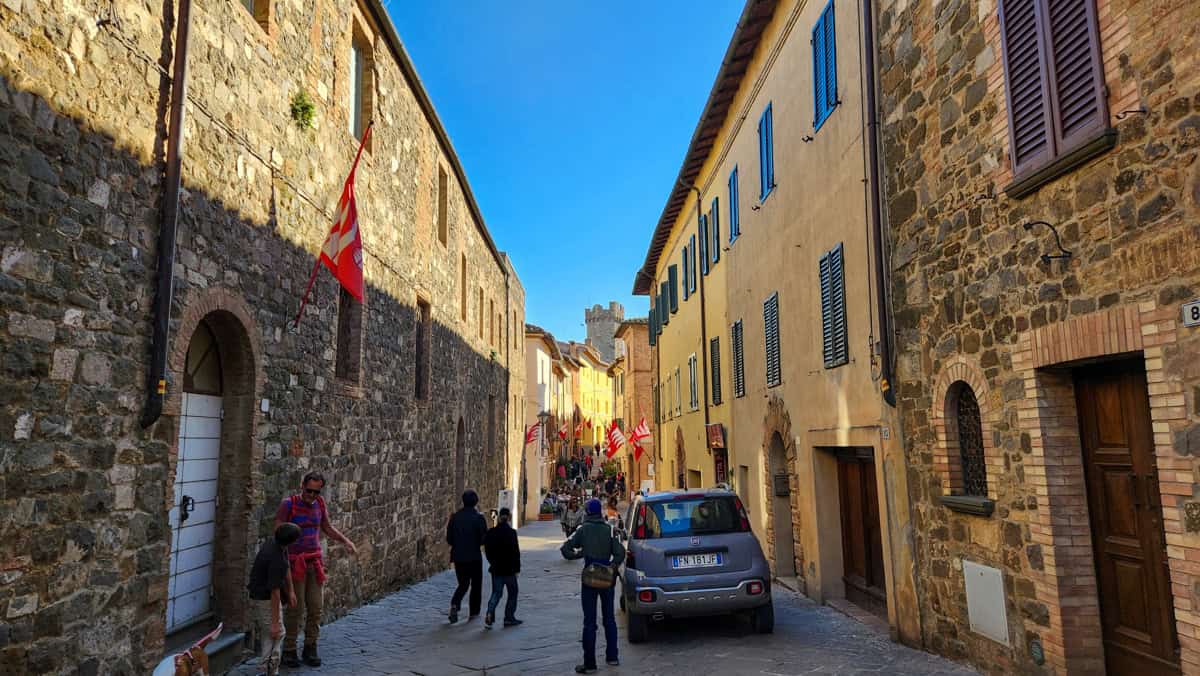
The History of Montalcino and the Birth of Brunello
When we first dove into Montalcino’s history, we were amazed by how far back this little town’s story goes. The first mention of Montalcino dates to 814 AD in records from the Abbey of San Salvatore. By the Middle Ages, the town had evolved into a fortified settlement, and it’s easy to see why – perched on a hill, it feels like a slice of Tuscan magic frozen in time.
The region’s wine story began to unfold in the early 14th century, with evidence of viticulture marking the roots of what would become one of Italy’s most celebrated wines: Brunello di Montalcino.
Brunello di Montalcino is crafted from 100% Sangiovese grapes and is known for its complexity, aging potential, and bold flavors.
One of our favorite things about exploring Brunello’s history was learning about the people who made it what it is today. Clemente Santi, a local farmer in the mid-19th century, was the first to isolate specific Sangiovese clones to produce a pure varietal wine. His work was groundbreaking, but it was his grandson, Ferruccio Biondi-Santi, who truly transformed Brunello.
In the late 1880s, Ferruccio released the first modern version of Brunello di Montalcino. This wine, aged for over a decade in large wooden barrels, set the standard for quality and craftsmanship that Brunello is still known for today.
By the mid-20th century, Brunello was renowned as one of Italy’s rarest and most sought-after wines, with Biondi-Santi as the sole commercial producer. (Even if you aren’t a wine expert, you’d recognize the name on the bottle as it’s very popular in the US.)
Brunello’s fame continued to grow, and in 1968, the Montalcino region was granted DOC (Denominazione di Origine Controllata) status, which recognized the area’s exceptional wine quality. Then, in 1980, Brunello di Montalcino became one of the first wines in Italy to earn DOCG (Denominazione di Origine Controllata e Garantita) status, the highest level of quality assurance for Italian wines.
Today, nearly 200 producers contribute to Brunello’s legacy, with annual production reaching approximately 330,000 cases. We were fascinated to learn that the United States is one of Brunello’s biggest markets – so many restaurants in the US showcase this incredible wine, which makes us feel a little closer to Tuscany when we visit the U.S.
Paradiso di Cacuci
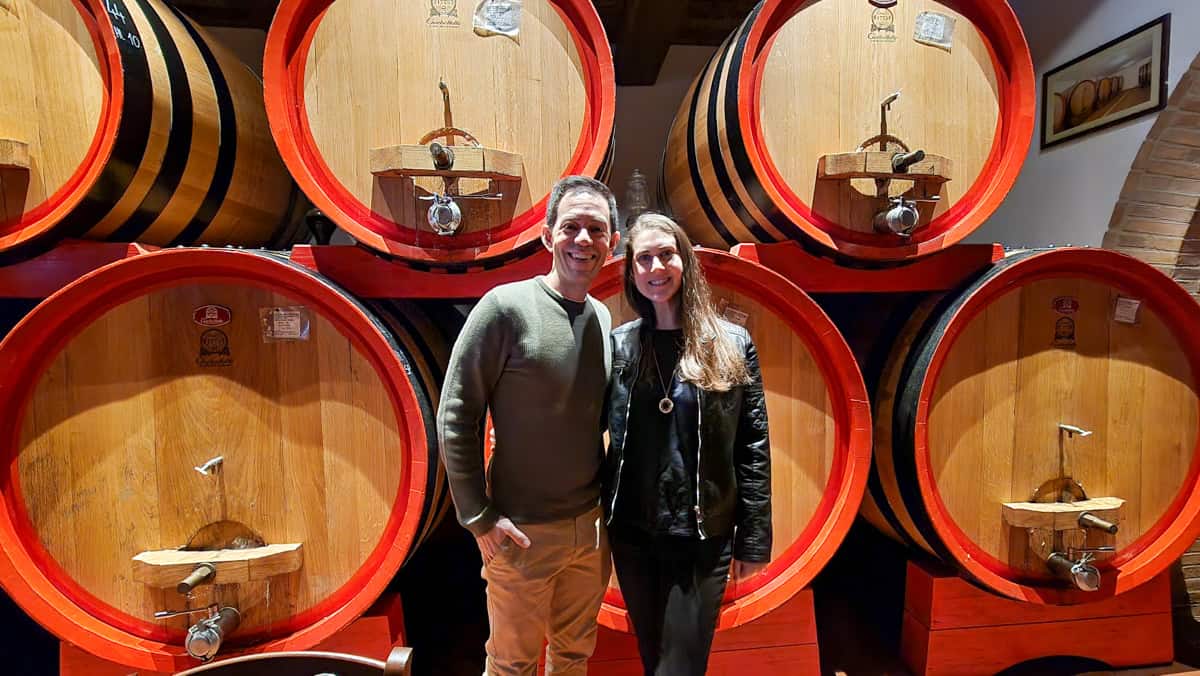

- Hours:
- Daily from 10:30 AM – 4 PM
- Reservations Required: Yes
- Online booking available: Yes, via form
- Tastings start at: 25€ pp
We started our wine-tasting adventure at Paradiso di Cacuci, a family-owned winery founded in 1964, just before the region gained its DOC status.
Perched at an elevation of 1,213 feet (370 meters), this winery is all about high-quality production straight from its own vineyards. To further prove that, this wine producer was one of the first members of The Consortium of Brunello di Montalcino, an association of winemakers whose goal was to protect their precious product and emphasize its best qualities.
Paradiso di Cacuci experienced a remarkable transformation in 2018 when it was acquired by Gogu Cacuci, a doctor and entrepreneur from Transylvania (wonder if Dracula likes wine). His vision brought new investments and a modern approach to management while staying true to the winery’s traditional roots.
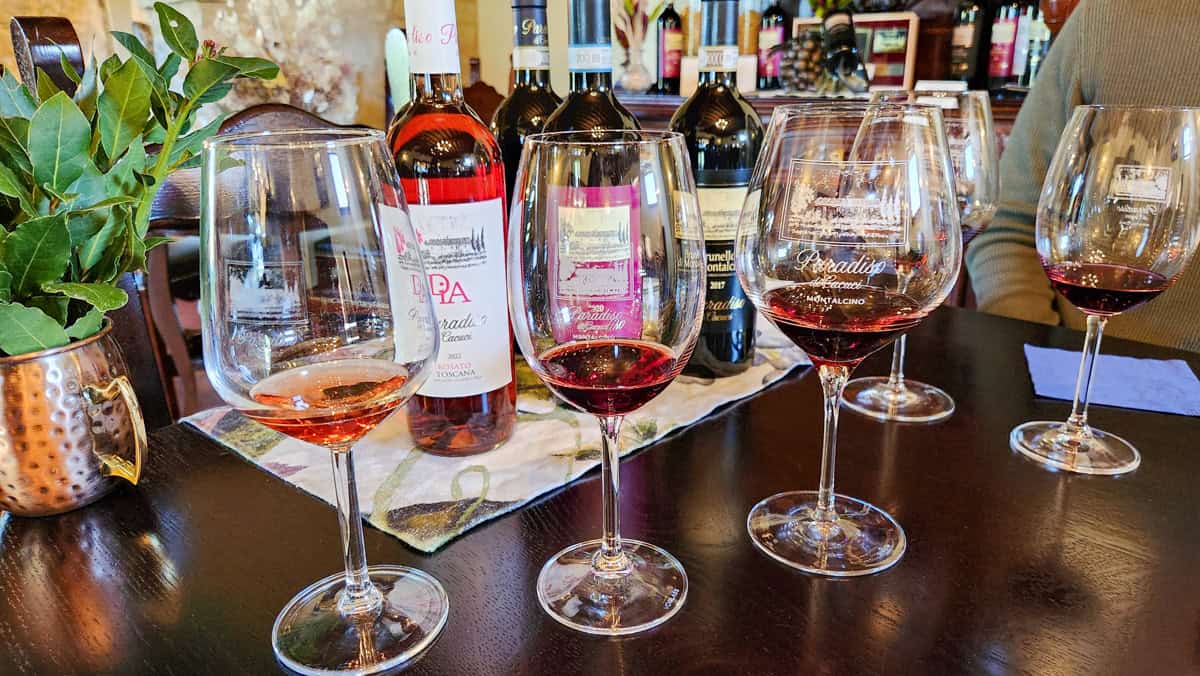
We did the cellar tour and tasting which included 5 wines and a small plate of food. The grounds were absolutely beautiful and really set the tone for our winery-filled weekend.
We purchased a bottle of Rosso di Montalcino (Brunello’s little brother) which was both affordable and smooth.
Note*: There are two ways to get to the winery from Montalcino that Google recommends. The shorter distance takes you down the backside of Montalcino on a narrow, one-way road that has sections of 15-20% grades. If you get nervous easily (like Sam), we recommend going the longer way to avoid this unique, off-roading adventure.
Lunch in Montalcino
After our tasting, we wanted to wander through Montalcino’s town center for lunch at one of its charming trattorias, but we sorely underestimated how long we needed to find parking and then walk up to town from the lot.
Like we mentioned above, most wine tastings take at least an hour and when we booked everything, we did factor in drive time but failed to account for the few times we had to circle for parking as we were getting there right before the lunch rush. This cut into the time we were able to explore the town and sit for lunch.
Instead of doing a sit-down lunch, we grabbed some slices of pizza from Petto’s Pizza and ate in the square. The pizza had just come out of the oven and was good. To be clear, it wasn’t the best pizza in the world but 4 slices and a coke were 12€.
Don’t make our mistake…do as we say, not as we do.
Give yourself a few hours to stroll through the town’s medieval streets and stop by the Fortezza di Montalcino for stunning vistas of the surrounding countryside.
San Polo
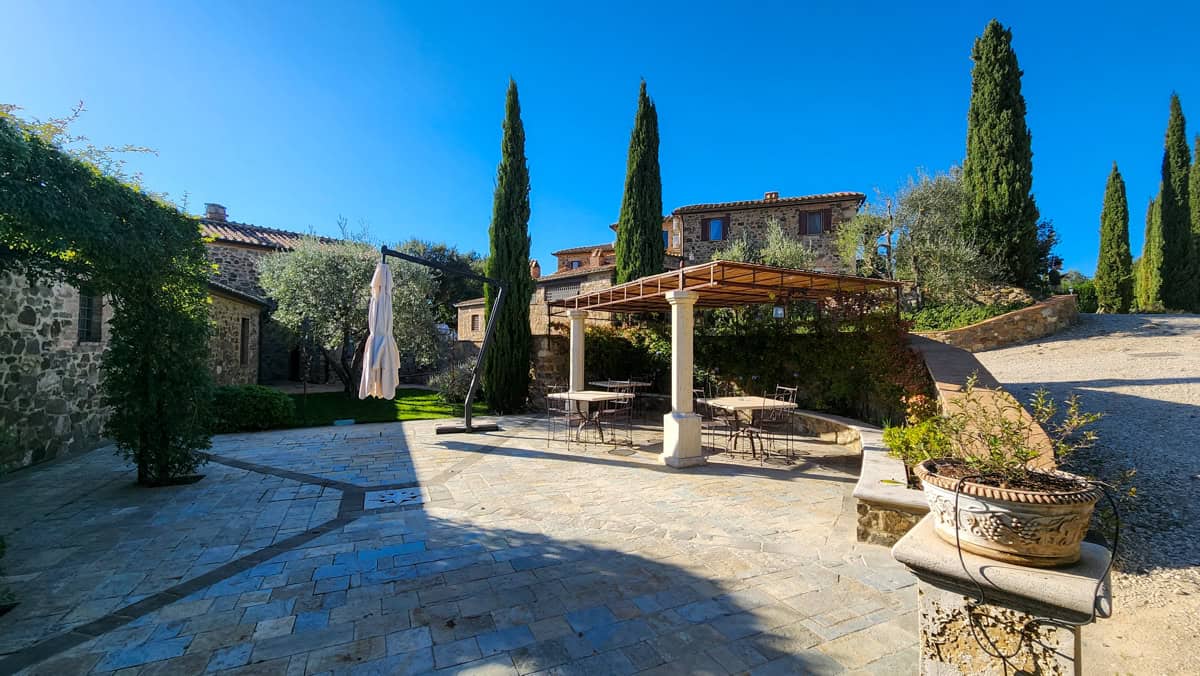
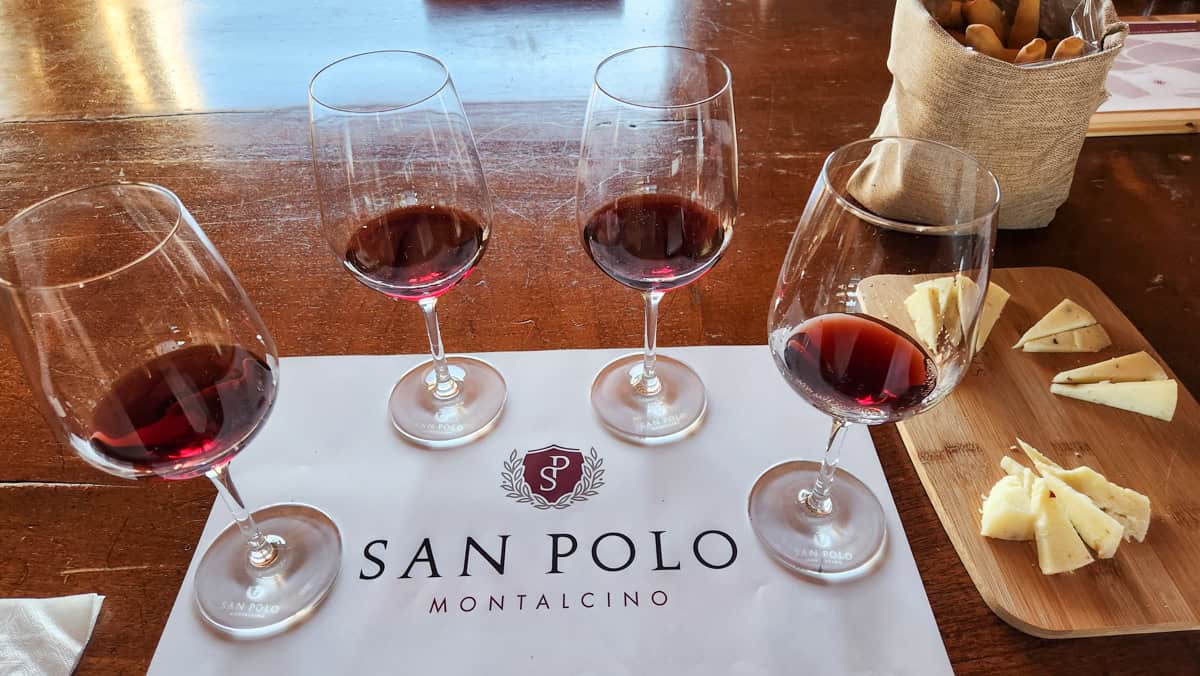
- Hours:
- Daily from 10:30 – 4:30 PM
- Reservations Required: Yes
- Online booking available: Yes
- Tastings start at: 25€ pp
Our next stop at San Polo was nothing short of breathtaking. Founded in 1994 in the heart of Brunello’s original production zone, this stunning winery sits at an elevation of 1,476 feet, making it one of the highest in the region. Its unique location spans 54 acres, with 40 acres of vineyards, including 20 acres devoted solely to crafting Brunello di Montalcino DOCG.
In 2007, San Polo entered an exciting new chapter when it was acquired by Marilisa Allegrini, a powerhouse in the wine world. Today, her daughters, Carlotta and Caterina, lead the winery with passion and a forward-thinking vision, carrying on their family’s celebrated legacy.
San Polo’s commitment to sustainability is woven into its DNA. The winery holds both organic certification and the coveted CasaClima certification, a testament to its eco-conscious approach at every stage of winemaking. From the vine to the bottle, respect for the environment is at the forefront.
We lucked out that no one else booked during our tasting so we had a private wine tasting which consisted of 4 wines and a small plate of cheese and meats. The view from their tasting room was hard to beat overlooking a valley and mountains. It honestly looked like a picture looking out their tasting room window.
After the tasting, we were allowed to walk up to the vineyard and take photos. Like always, the pictures will never do this place justice and you just have to take our word for it, it was beautiful.
Terralsole
- Hours:
- Monday to Friday: 9:30 AM – 12:30 PM & 3:00 PM – 6:00 PM
- Reservations Required: Yes
- Online booking available: Yes
- Tastings start at: 40€ pp
While we said earlier that you have to have reservations to taste, we were the dumb tourists who decided to show up on a whim and hope for the best. Remember, do as we say, not as we do!
Well, in this situation, it actually worked out. Terralsole was recommended to us by our new friend in Bologna who is a sommelier. Let’s just say when an Italian sommelier recommends a winery, just go. He was NOT wrong about this place as it was one of our favorites during our Tuscany road trip.
Terralsole was just a 5-minute drive from San Polo and we lucked out catching one of the owners, Athena, on the property. Athena graciously let us do a quick tasting, packing in as much history and information about the winery and the region as she could during our impromptu tasting. We liked the wine so much that we purchased 3 bottles.
As of writing this post, we have been to literally 200+ wineries – did we mention that our livers appreciated the slower pace?
And this winery does something that we don’t think we’ve ever really seen before…they age the wine for you.
Most wineries (especially in the US) will tell you to “lay the bottle down” for a certain number of years to really allow the wine to mature so that when you drink it, it’s the best it can be.
Terralsole does that for you.
They cellar the wines for you so that when you buy them, they are ready to drink. Because nothing is worse than buying a wine you love and then having to wait several more years to actually drink it. We purchased a 2008 Brunello, 2007 Cabernet Franc blend, and a 2006 Brunello Riserva. In terms of wine quality and in our opinion, they were some of the best wine and this place/tasting with Athena will stay with us for a while. We highly recommend them!
They also offer lodging if you want to stay onsite. Of note though, it’s roughly 20-25 minutes from town in the countryside.
Dinner in San Quirico d’Orcia: Fonte alla Vena
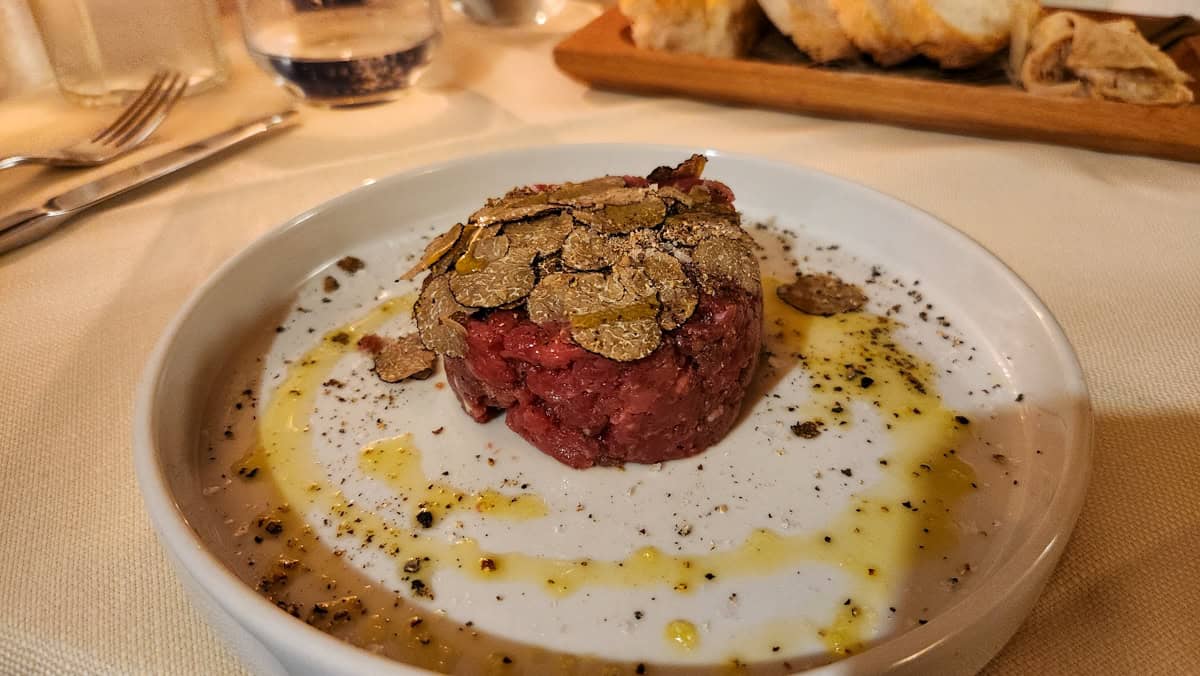
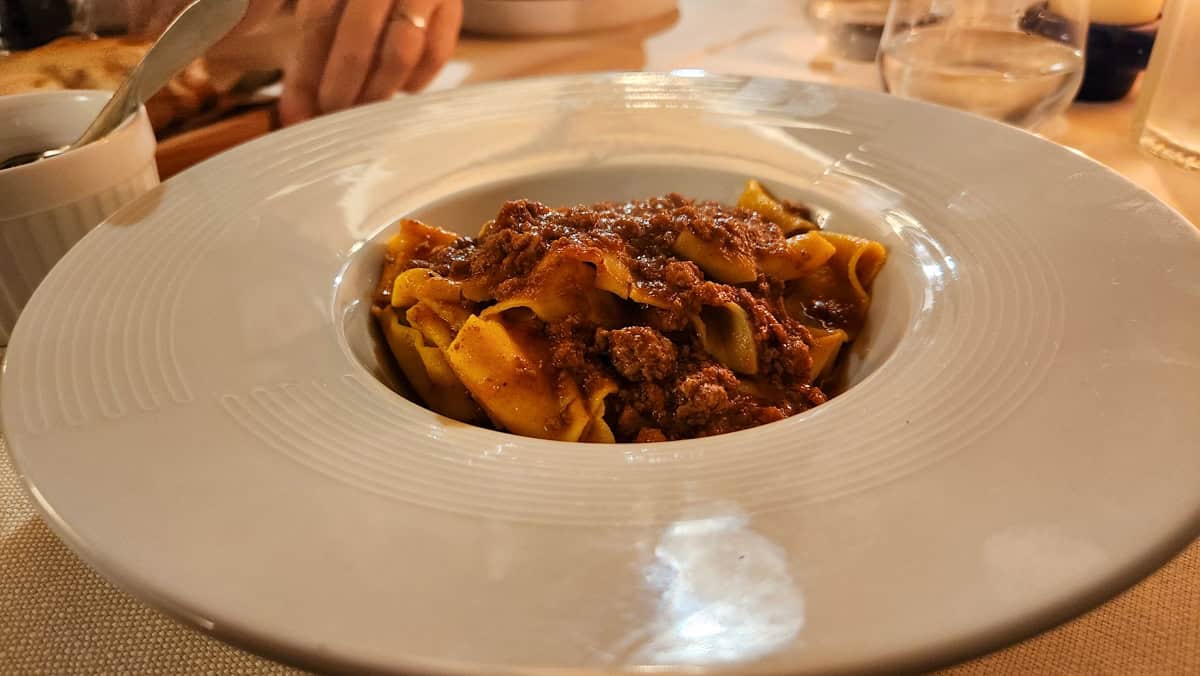
- Hours:
- Wednesday – Monday: 12:30 PM – 3 PM & 7:30 PM – 9:30 PM
- Tuesday: Closed
- Reservations Required: Yes
We made dinner reservations strategically in San Quirico d’Orcia which was on the way back from Montalcino to our lodging.
Our dinner at Fonte alla Vena was an unforgettable experience—a perfect spot for anyone looking to savor a romantic, tranquil evening in the heart of Tuscany. Tucked away in the charming town of San Quirico d’Orcia, this restaurant has roots dating back to the 17th century when it was an inn, making it steeped in history and tradition.
Fonte alla Vena focuses on quality over quantity, offering a thoughtfully curated menu inspired by the flavors of the Val d’Orcia region.
Every dish is crafted with locally sourced, organic ingredients that honor the environment and the region’s culinary heritage. It’s really no surprise that this gem has earned a spot in the MICHELIN Guide Italy 2024.
It’s intimate and romantic, with a relaxing vibe that makes it easy to sink into the moment.
I (Sam) enjoyed the beef tartare to start, followed by handmade pici pasta tossed in a rich aglione garlic and tomato sauce, and the classic pappa al pomodoro—a hearty Tuscan tomato and bread soup.
Chris went for handmade pappardelle with a savory Tuscan meat ragù and finished with Cinta Senese pork ribs glazed in honey and smoked paprika.
Every bite was a celebration of Tuscan tradition, brought to life with impeccable care and artistry. If you’re planning a road trip through Tuscany, this is a must-visit destination for a dining experience you’ll be talking about long after the last bite. Make sure you get reservations!
Montepulciano

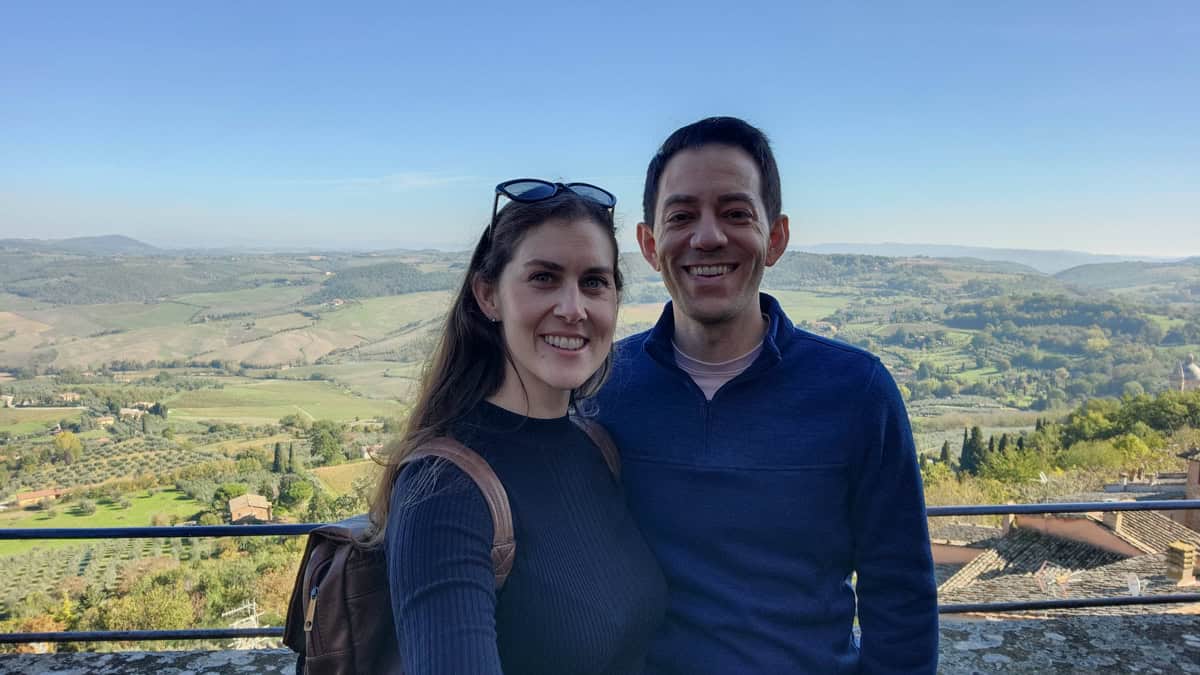
History of Montepulciano and Wine
Montepulciano’s roots date back to the 3rd century as the Roman settlement of Mons Politianus, laying the foundation for the town’s strong connection to both its land and wine production.
In 789 AD, vineyards were first mentioned, and a cleric’s donation of land to the Church of San Silvestro marked the beginning of a rich viticultural legacy.
By the 14th century, Vino Nobile gained recognition, becoming one of Tuscany’s oldest wines.
The 17th century brought further acclaim, with a poet calling it “the king of all wines” and King William III of England sending an emissary to secure it, further cementing its international reputation.
As Chianti’s fame grew, Montepulciano’s wine faced decline, with many local producers labeling their wines as Chianti. In the 1920s, Adamo Fanetti led the push to restore the Vino Nobile name, reigniting pride in the wine.
By 1931, Vino Nobile was featured at Siena’s first wine trade show, and by 1966, it received DOC status. In 1980, Vino Nobile di Montepulciano became one of the first wines to earn DOCG status, marking it as one of Italy’s finest.
Vino Nobile is primarily made from Sangiovese, known as Prugnolo Gentile, with varietals like Mammolo adding a distinctive violet aroma. Unlike Chianti, Vino Nobile requires at least one year of wood aging, with a total aging of two years for the standard wine and three years for Riservas.
Only wines that meet these strict aging requirements qualify for DOCG status; others are labeled Rosso di Montepulciano DOC. This commitment to quality ensures Vino Nobile remains a celebrated wine in Tuscany’s rich heritage.
Vecchia Cantina di Montepulciano
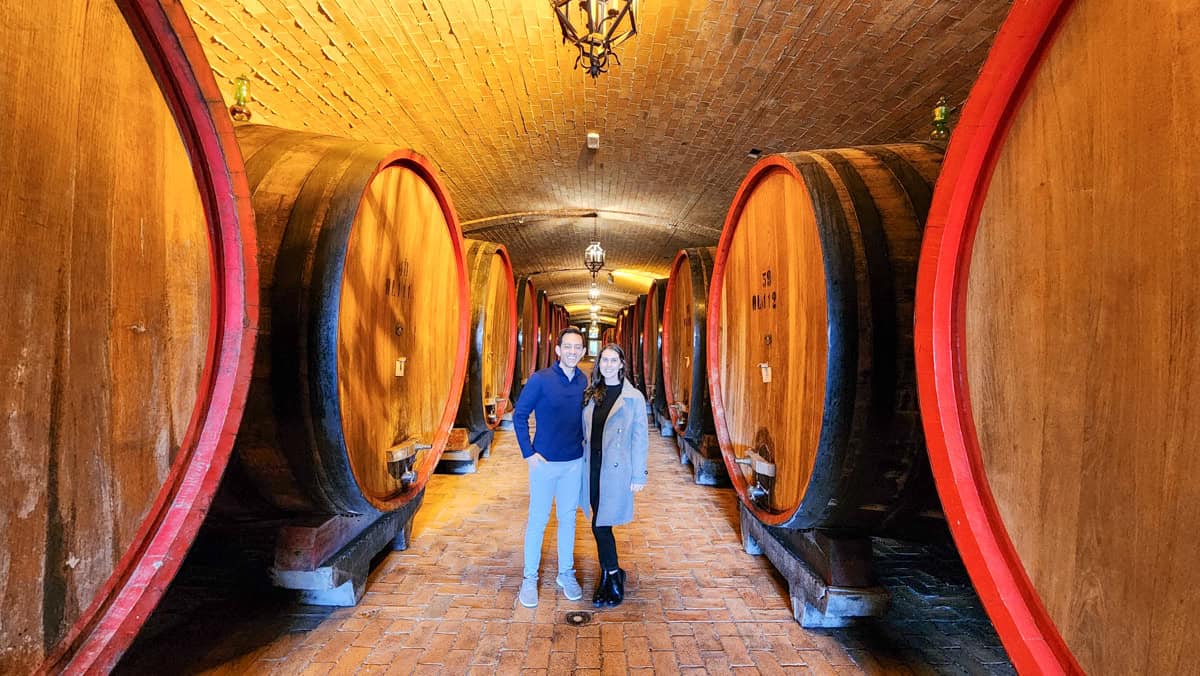
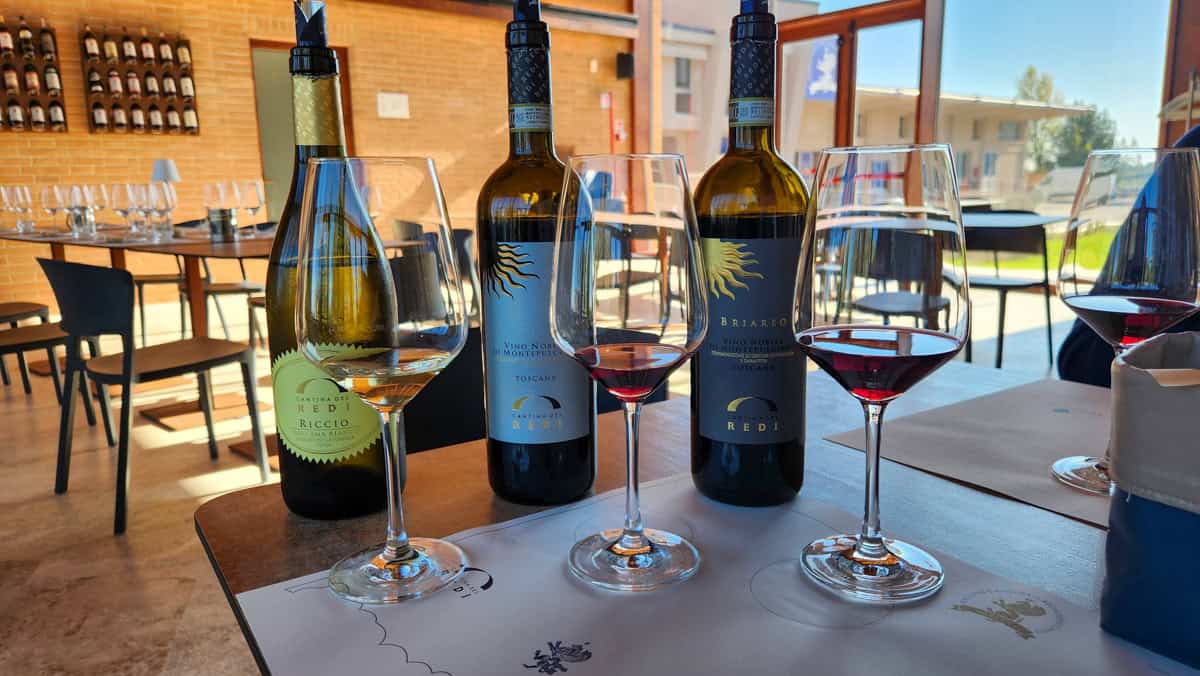
- Hours:
- Daily from 10 AM – 4:30 PM
- Reservations Required: Yes for a tour
- Online booking available: Yes
- Tastings start at: 5€ pp (if you drink at the bar)
- Tours + Tastings start at 25€ pp
Our first stop in Montepulciano was Vecchia Cantina, the region’s oldest cooperative winery, established in 1937. This winery has long been a hub for local producers to collaborate and create exceptional wines, making it a key player in Montepulciano’s winemaking history.
We toured their cellars to learn how Vino Nobile is crafted and enjoyed a tasting that highlighted the depth and complexity of their wines. With options to suit every palate, Vecchia Cantina offers a genuine taste of Tuscany’s winemaking excellence.
Unbeknownst to us at the time, Vecchia Cantina is the largest producer in the area. We did a 10 a.m. tour and tasting (can’t drink all day if you don’t start in the morning), which included visits to three different cellars, and we sampled four wines along with the Vin Santo liqueur, all paired with crackers.
While we had a great time on the tour, you can save a little cash by just showing up for a tasting at the bar. Since they’re the largest producer, we didn’t buy a bottle that day, but we’ve since picked one up at our local grocery store in Bologna. They even distribute in the US – if you’re near a Total Wine, look out for this brand.
De’Ricci Cellars
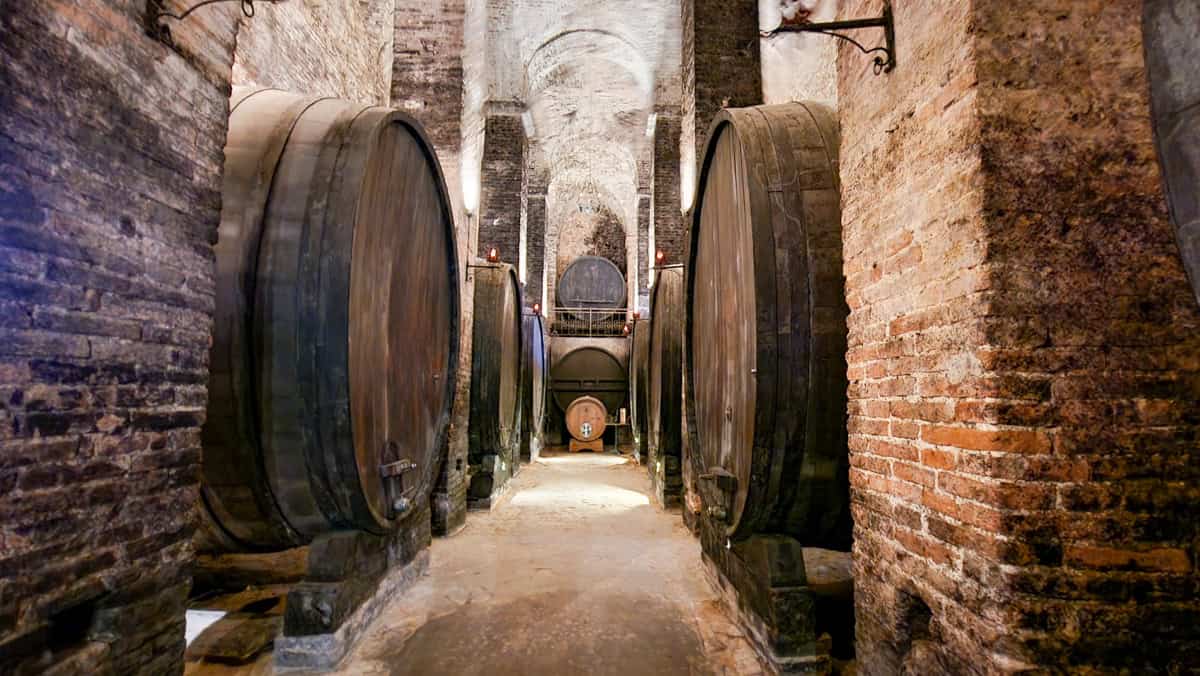
- Hours:
- Daily 10:30 AM – 5 PM
- Reservations Required: Yes
- Online booking available: Yes
- Tastings start at: 20€ pp
De’Ricci Cellars is a true gem, filled with the rich history of Montepulciano and its renowned Vino Nobile. This ancient cellar invites us to step back in time and explore the stories, faces, and dreams that have shaped their exceptional wines.
We toured the famous Cathedral cellar, descending into the caves and learning all about Montepulciano’s wine history. The Rupe del Sasso cave was believed to be hand-dug dating back to the Etruscan era.
The first wine cellar was established in 1337, following local laws, while the stunning Wine Cathedral was commissioned in the 16th century.
This wine cathedral is renowned for its Roman-Gothic arches and cross vaults, giving it the ambiance of a grand, ancient cathedral. The cellar itself is carved into the volcanic rock beneath the city, providing perfect conditions for aging wine due to the constant temperature and humidity.
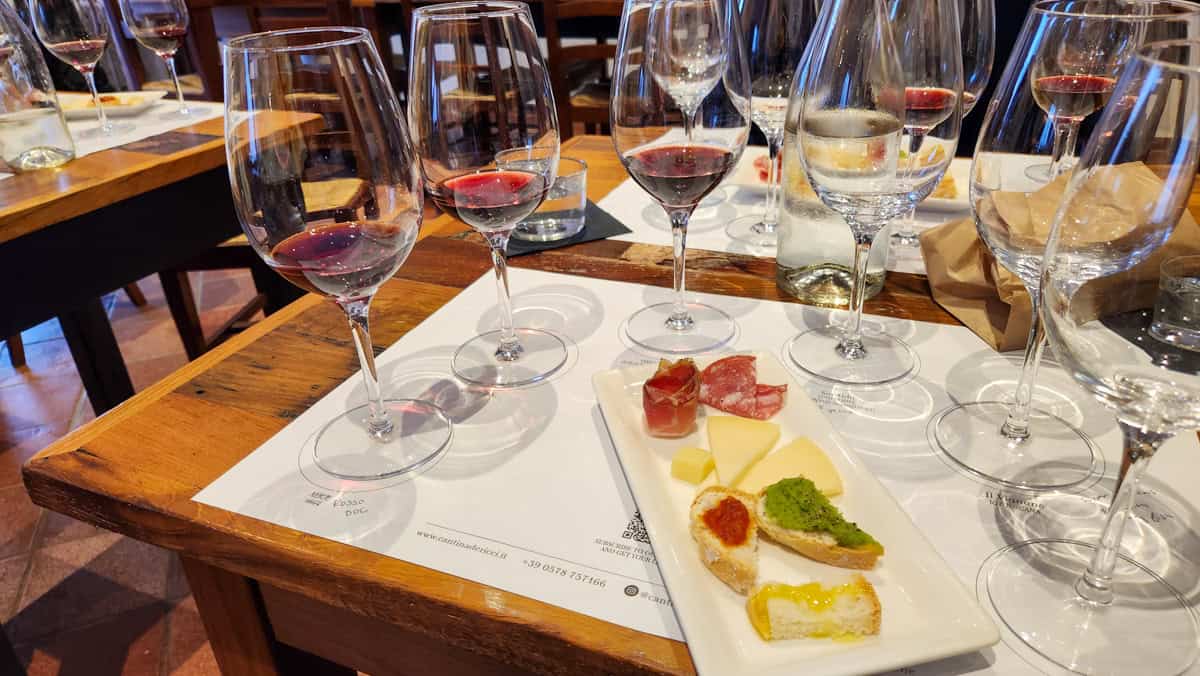
While the cellar is no longer actively used in production, the gigantic barrels remain and we were truly awe-struck by the enormity of this space and the architectural design that went into it.
At the end of the tour, we had the option to taste either three or six wines (we went with six, no surprise there 😉) paired with a small plate of snacks.
We completely understand why this cellar is considered one of the most beautiful in the world and would highly recommend taking the tour.
Podere della Bruciata Winery
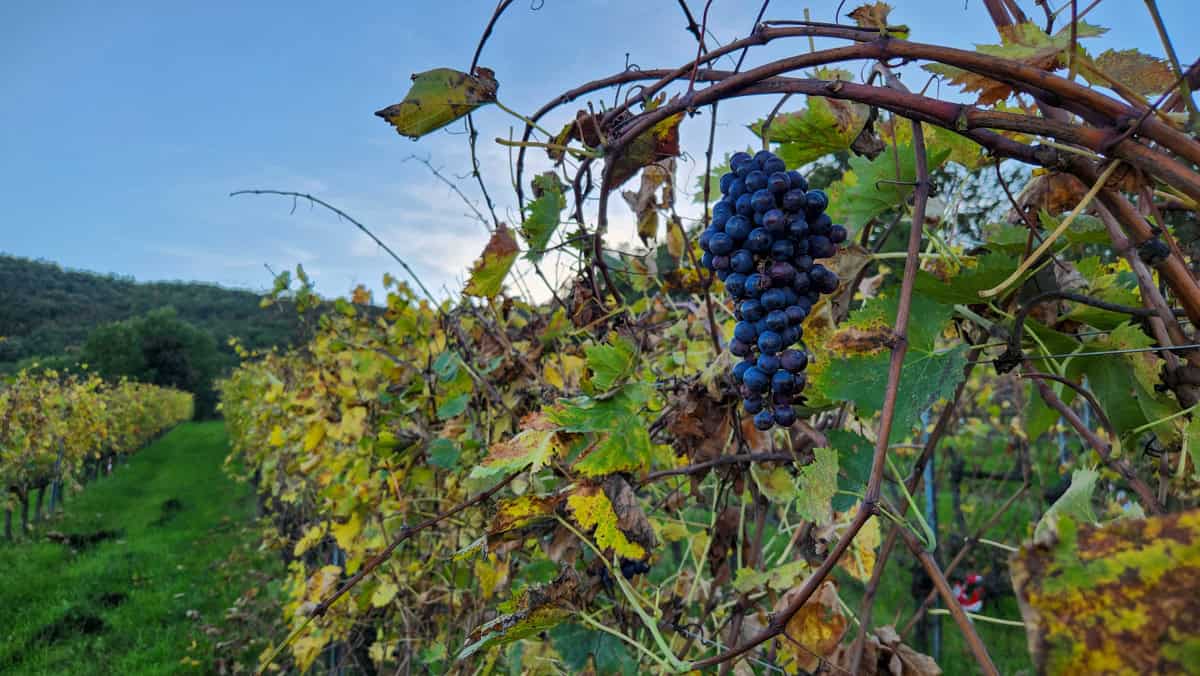
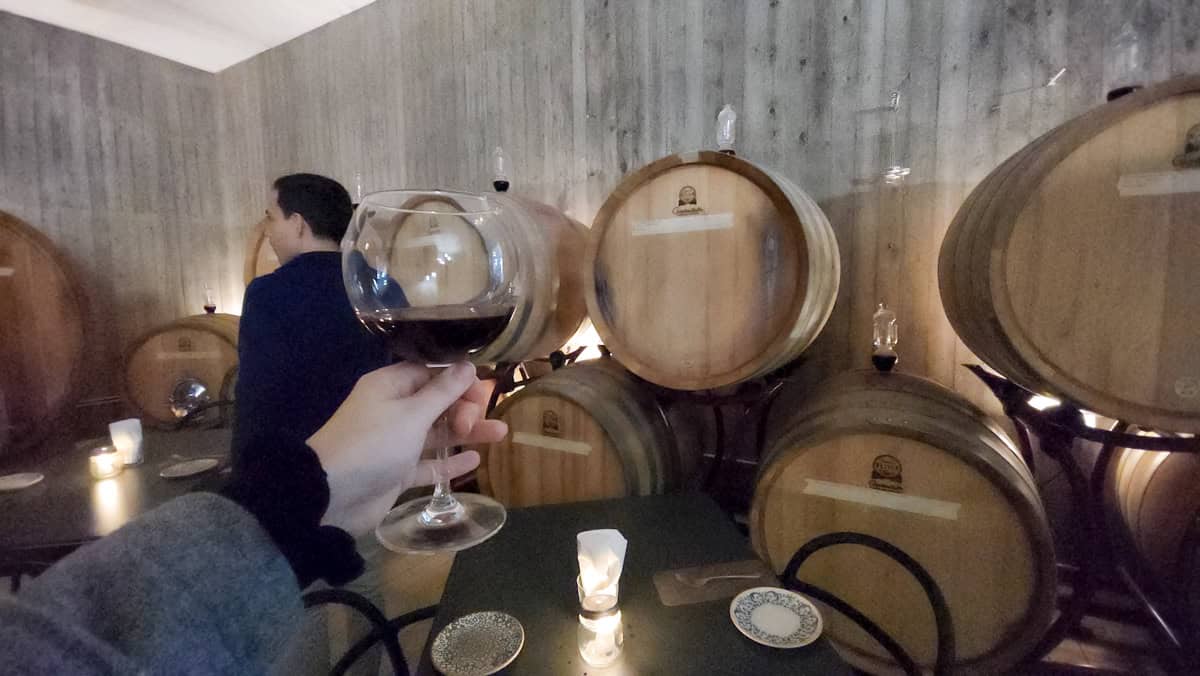
- Hours:
- Daily 11 AM – 5 PM
- Reservations Required: Yes
- Online booking available: Yes
- Tastings start at: 30€ pp
Podere della Bruciata Winery is located roughly 15 minutes outside of Montepulciano and was our last stop of the day.
A very small producer, this winery is family-owned and operated and made you feel like part of the family from the very beginning of our tour. The tour included a visit to the vines where we were taught about the history of wine, the grapes in the region, as well as the family’s history in winemaking.
The most unique story we learned was how this winery’s logo was created. The winemaker’s son was in the woods playing as a boy and was attacked by a wild boar. (Wild boar are quite common in Tuscany, hence the Cinghiale ragù you see all over this area). Their 2 dogs, both boxers, came to the boy’s aid by chasing off the boar and helping the boy home. Since then, they have always had boxers and their logo is a nod to them.
They have a few options for tastings but we chose to end our wine tasting weekend in Tuscany with a bang and did their wine and cocktail tasting. This included 3 wines and 1 cocktail with a generous plate of snacks. (The cocktail options were all gin-based so if you aren’t a fan of gin, just stick with the regular tasting.)
Pienza
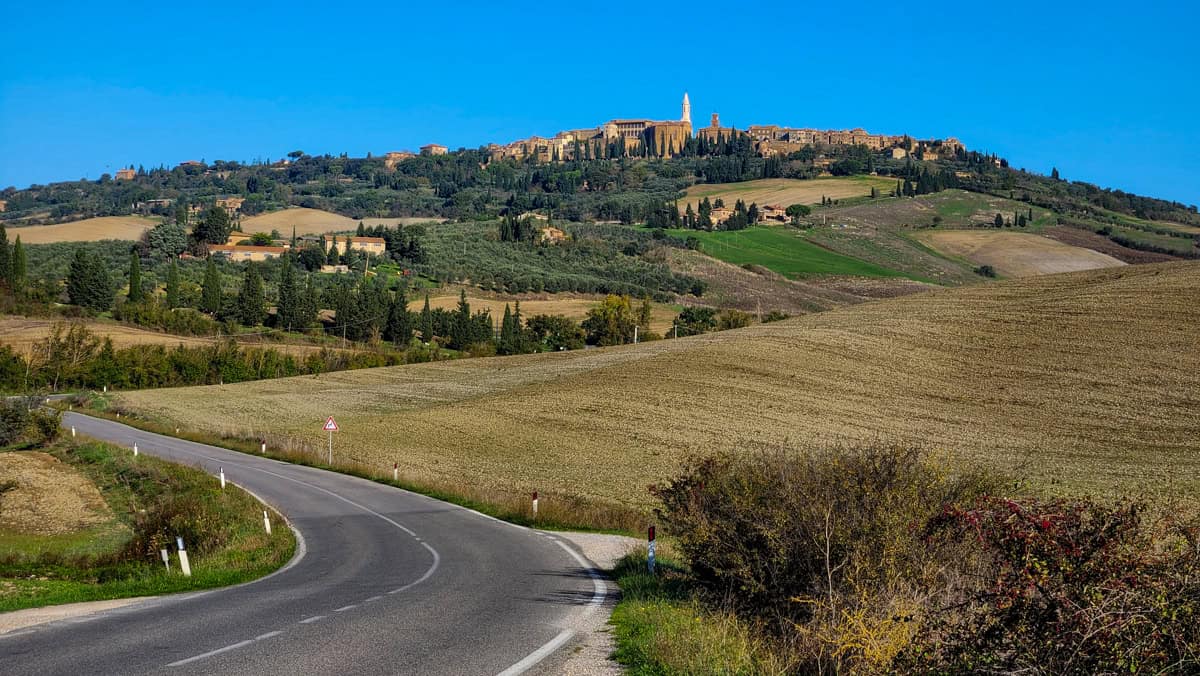
While we only did our nights in Pienza, we recommend adding it if you are planning a road trip to Tuscany.
Brief History of Pienza
Often called the “ideal city of the Renaissance,” Pienza is nestled in the heart of Tuscany within the stunning Val d’Orcia region.
Originally known as Corsignano, this charming town has roots dating back to the Etruscan period, around the 8th century BC.
However, it underwent a remarkable transformation during the 15th century under the vision of Pope Pius II, who was born Enea Silvio Piccolomini in Corsignano. Inspired by Renaissance ideals, he enlisted architect Bernardo Rossellino to redesign the town as an embodiment of these values.
Construction began in 1459, with the town’s layout centered around the Piazza Pio II. Surrounded by the Cathedral of Pienza, the Palazzo Piccolomini, and the Palazzo del Comune, Pienza’s design highlights proportion, beauty, and functionality, epitomizing the Renaissance focus on harmony.
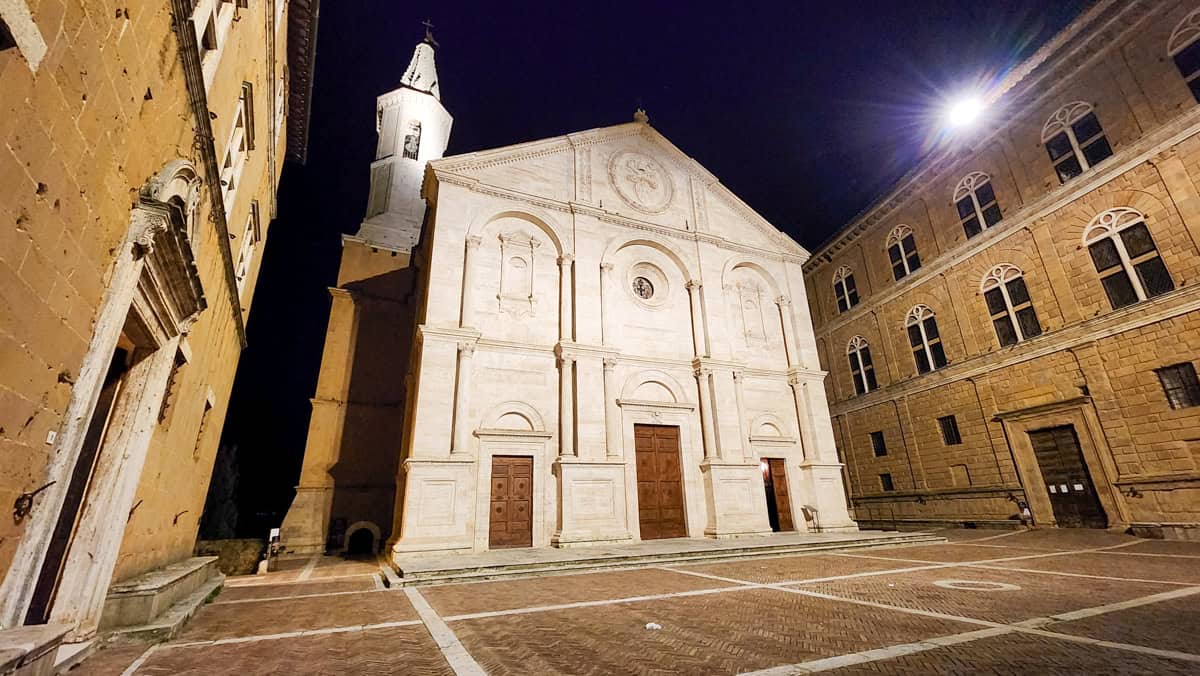
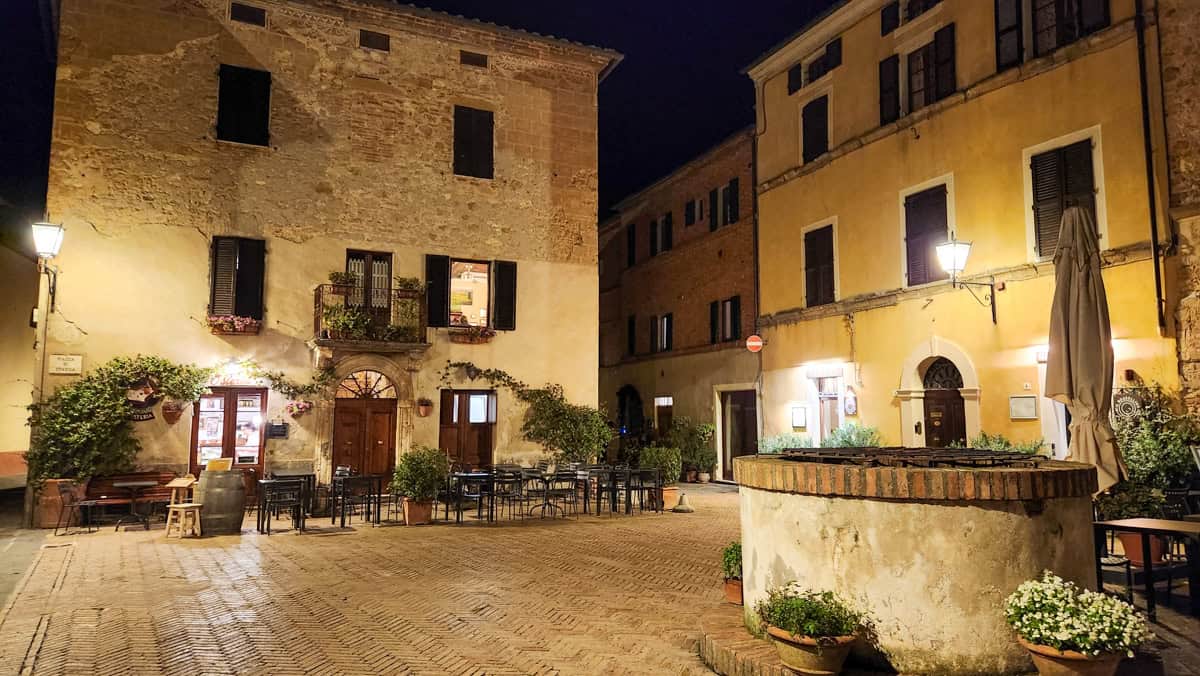
In 1996, Pienza earned UNESCO World Heritage Site status for its exceptional architecture and urban planning.
While Pienza may not produce wine on the same scale as nearby Montepulciano and Montalcino, the region’s fertile land supports vineyards growing Sangiovese, Trebbiano, and Verdicchio.
The town is more famous for its Pecorino cheese, made from sheep’s milk produced by the area’s pecore, or sheep. Naturally, the cheese pairs wonderfully with the local wines, making it a culinary haven for those seeking authentic Tuscan flavors.
Azienda Agricola Casagori
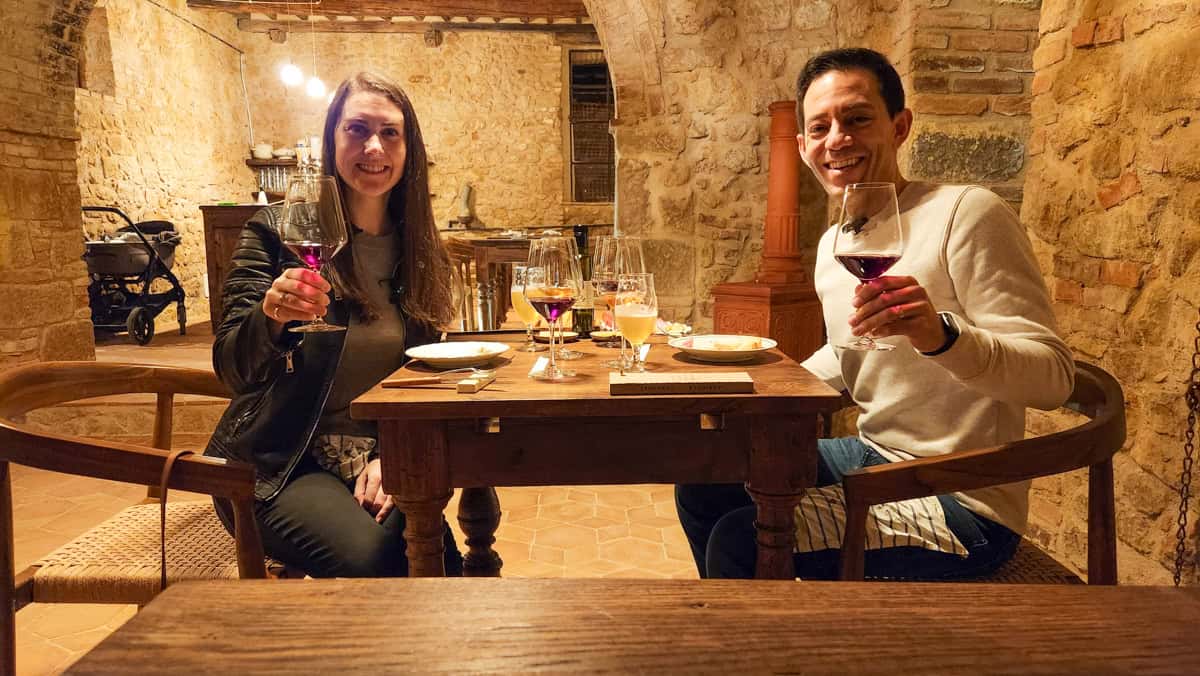
- Hours:
- Daily by appointment only
- Reservations Required: Yes
- Online booking available: Yes
- Tastings start at: 20€ pp
Just outside the charming town of Pienza, we discovered Azienda Agricola Casagori, a hidden gem that combines organic farming, winemaking, and brewing into one harmonious experience. Spanning 30 hectares in the heart of Tuscany, this estate operates without artificial fertilizers or herbicides, letting the natural ecosystem—including their animals and bees—do the work.
At Casagori, the focus on organic and biodynamic methods is palpable in every sip of their creations. Their unfiltered wines, like their signature Libero, embrace authenticity with a light natural sediment, offering a pure and unpretentious taste of the land. Each bottle feels like an ode to Tuscany itself, carrying the gentle winds and the sun-soaked essence of the Val d’Orcia.
With breathtaking views of the rolling Tuscan hills, the estate’s offerings go beyond wine.
We reserved their tasting which included a craft beer, 3 wines, and savory local cheeses like pecorino.
La Tana Del Goloso
- Hours:
- Daily from 9:30 AM – 8 PM
- Reservations Required: No
We popped into La Tana Del Goloso cheese shop and did a sampling of pecorino cheese via a take-away box that we ate in the square one night.
They don’t have a website, but their Facebook seems to be active. If you are looking to do a cheese tasting while you visit, we thoroughly enjoyed ours and even had some leftovers for our drive home the next day.
Sette Di Vino
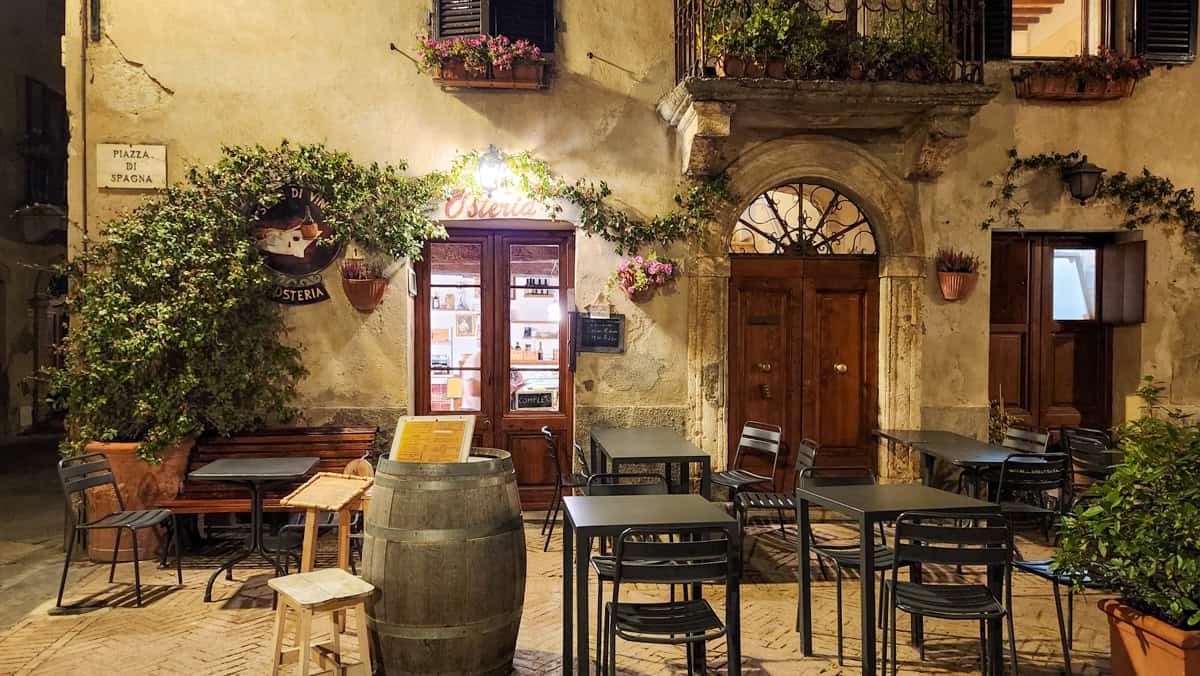
- Hours:
- Thursday – Tuesday: 12 PM – 2 PM & 7:30 PM – 9 PM
- Wednesday: Closed
- Reservations Required: Yes
- Online booking available: No
Sette Di Vino is a small, tapas-style restaurant in the heart of Pienza. They don’t offer pizza or pasta which was a lovely break from the traditional Italian foods (no coffee either, if that matters to you). We wanted a lighter meal so this was a perfect choice for us. We split a bowl of soup, beef carpaccio, and a caprese salad.
There are probably only 10-15 tables total so you must get a reservation if you want to eat here. The server was fantastic, very lively, and helpful when we had questions.
Bagni di San Filippo
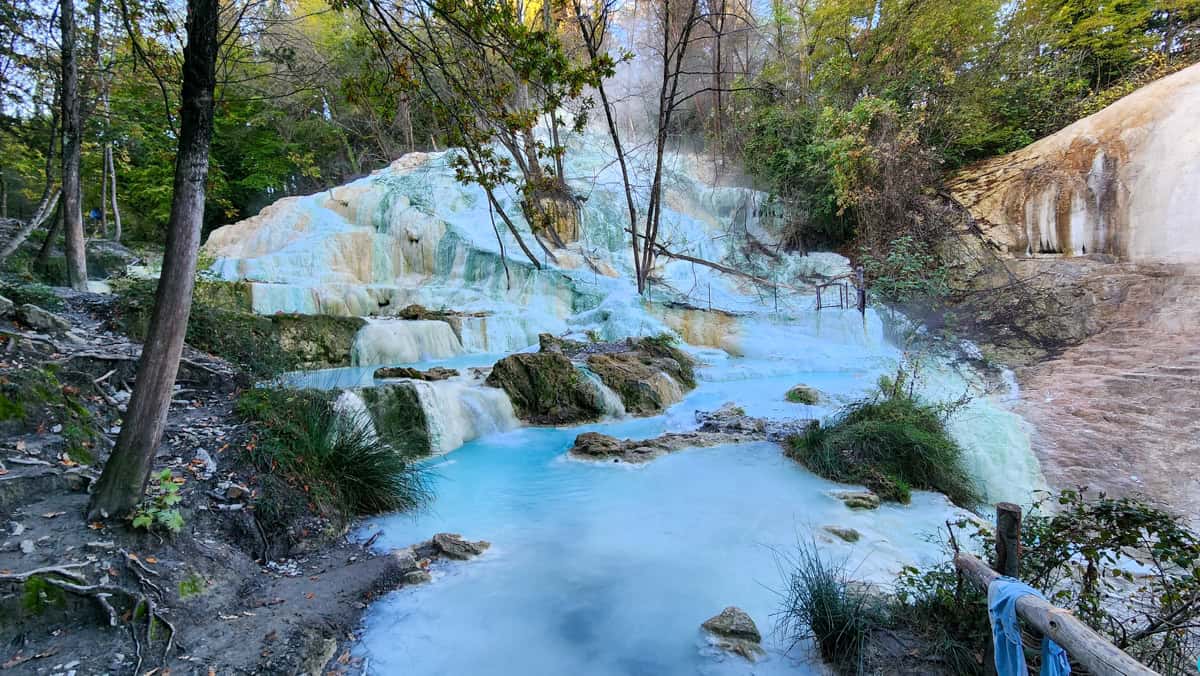
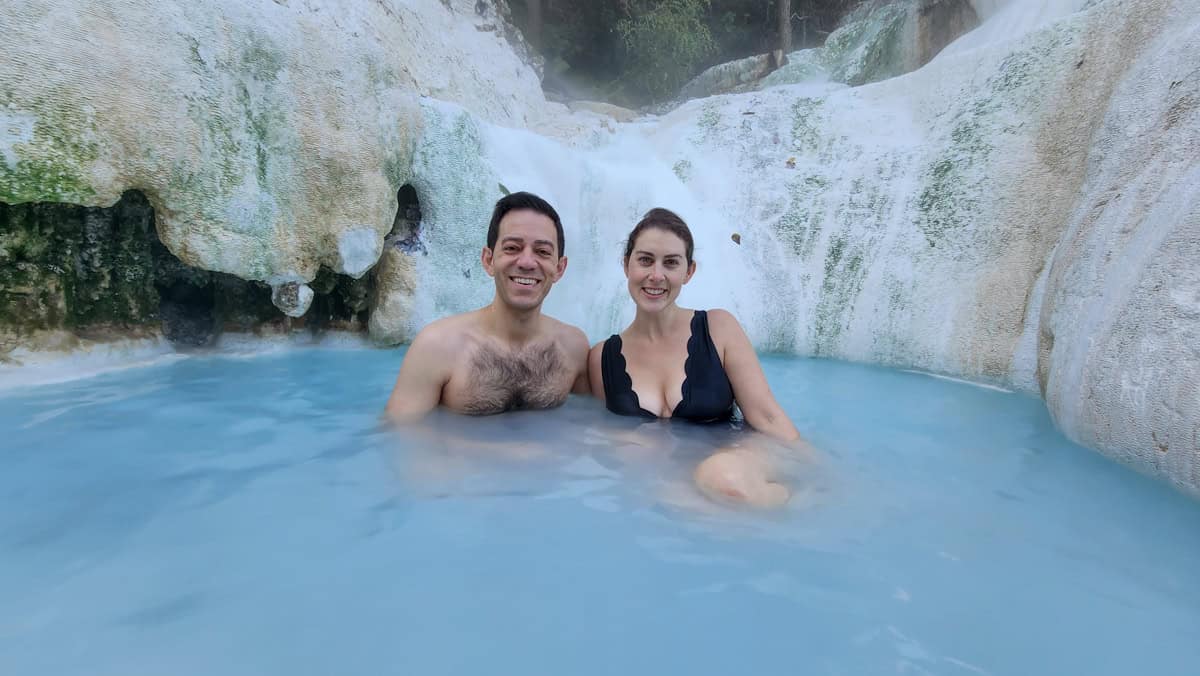
- Hours: 24/7
- Cost: Free (except for parking)
We woke up early one morning to drive about 25 minutes to visit the “White Whale” at the Bagni di San Filippo. While the hot springs are “free” to visit, you do need to pay for parking and if you haven’t figured this out by now, parking is limited in these parts.
We arrived around 7 a.m. and there were only a handful of people there, but when we left around 8:30, it was getting crowded.
Bagni di San Filippo has been a sanctuary of relaxation and rejuvenation for literal centuries, drawing visitors since ancient times.
The story begins with the Etruscans and Romans, who were some of the first to embrace these natural hot springs. Archaeological evidence reveals that the Romans, in particular, built baths around the springs, weaving them into their culture of wellness and communal bathing. For them, these waters were not just about relaxation but a way to restore and heal the body.
By the Middle Ages, the springs took on a more spiritual dimension. The nearby Abbey of San Salvatore, established in the 8th century, became a focal point of the region. The monks believed in the springs’ healing benefits, and the area became a blend of natural beauty and sacred retreat. These hot springs were visited by the same monks that wrote about Brunello in the 9th century.
We specifically went to visit the “White Whale” known for its milky-white pools and cascading formations. It was roughly 47 degrees F when we arrived and it took some trial and error (mostly very cold errors) to find warmer water to sit in.
Walking among the cascading mineral formations and soaking in the warm, mineral-rich waters, we felt connected to centuries of history and a tradition of Tuscan wellness that has stood the test of time.
Things to know before visiting
- Wear water shoes, the bottom of the springs had some sharp rocks
- Bring a towel
- We went in the fall and while the water was warm, if you can’t get submerged, you will be cold.
- Get there as early as you can. The hot springs are beautiful, but there are limited “hot” pools to sit in. Get there early so you can snag one!
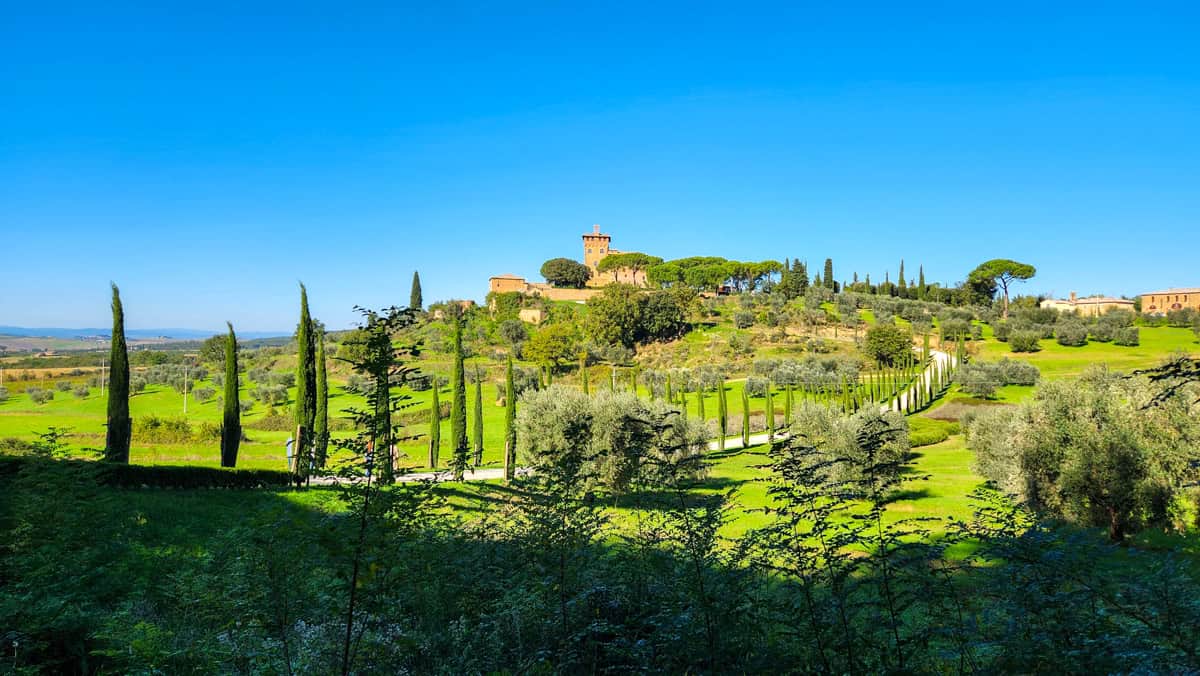
A road trip to Tuscany is more than just a vacation—it’s an immersion into the heart of Italy’s wine culture, history, and natural beauty. From the bold Brunellos of Montalcino to the classic Vino Nobile of Montepulciano, each day offers a new chapter in Tuscany’s rich story.
Whether you’re soaking in thermal springs, savoring Pecorino cheese, marveling at medieval architecture, or of course, savoring some delicious wine, this three-day itinerary promises an unforgettable experience. So pack your bags, hit the road, and let Tuscany’s magic unfold one vineyard at a time.
Psst! Looking for other Italy guides? We’ve got a bunch. Click here to see them all or check out the most popular below:
- The 5 Best Day Trips from Bologna, Italy
- Ultimate Road Trip to Tuscany: A Wine Lover’s Paradise
- The Best 3 days in Rome Itinerary Guide
- How to do Florence in 3 days – The Ultimate Florence, Italy Itinerary
Ready to visit to Tuscany? Read hotel reviews on TripAdvisor then book your room here!
Don’t forget to pick up a Tuscany guidebook for your other Italian adventures.
Love this guide? Have questions? Get in touch with us on Facebook | Youtube | Instagram | Pinterest
